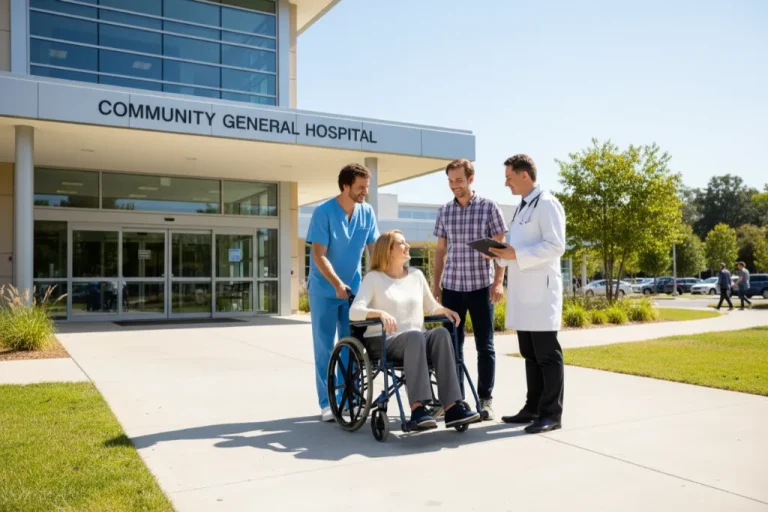What is a Transition Care Plan?
A transition care plan (TCP) is a comprehensive, person-centred document that outlines everything needed to support a person when they move from one care setting or service to community living. Transition Care Plans are used when a person moves between services, such as when young people transition from Child and Adolescent Mental Health Services (CAMHS) to Adult Mental Health Services, from child to adult services, from residential care to supported living, or when care providers change. Its purpose is to make the transition smooth, structured, and emotionally safe.
Rather than seeing discharge as a one-time event, a care transition plan recognises it as a process that requires careful coordination, detailed planning, and ongoing support. It brings together essential medical information, social circumstances, personal preferences, and practical arrangements into one cohesive strategy. The transition care plan documents:
- What kind of support does a person need?
- Who will provide it?
- How will it be delivered?
- What milestones indicate a successful transition?
The transition care plan also addresses emotional well-being, daily living skills, community integration, and long-term goals. What’s most important is that the person themselves, along with their family members and trusted carers, remains at the centre of this plan, ensuring they are the ones shaping every decision about their care journey.
Goals and Importance of a Transition Care Plan
The overall goal of transition care planning is to enable people to move safely from hospital to community living while maintaining their health, stability, and well-being. However, this simplified statement encompasses multiple interconnected objectives that, together, create the conditions for recovery and increased independence.
Improving People’s Outcomes and Continuity of Care
Transitions can trigger anxiety, distress, or trauma responses.
The transition care plan reduces fear and uncertainty by gradually and predictably preparing the person. By ensuring care plans remain coherent and consistent across settings, transition planning helps people consolidate their recovery and make genuine progress, rather than simply moving locations. This way, people start experiencing reduced anxiety about their move because they understand what to expect and who will support them. They’re more likely to feel more comfortable with their new care arrangements because these have been tailored to their needs and preferences.
Reducing Hospital Readmissions and Complications
When community providers understand a person’s history, warning signs, and effective management strategies, all of which should be well documented in the transition care plan, they can intervene early and prevent unnecessary complications. Hospital readmissions can be successfully avoided by:
- Conducting thorough assessments before discharge
- Anticipating potential complications
- Establishing robust community support networks
Smooth transitions not only improve outcomes for people but also free hospital capacity for others in acute need.
Enhancing Communication Between People and Care Providers
Transition planning service documents create a structured communication procedure for handover, ensuring all relevant information is transferred in accessible formats, identifying the responsible key contacts. All parties can access and refer to the transition care plan, including the person, their family, hospital teams, community providers, and primary care. These documents build a web of coordinated relationships where everyone understands their role, reducing anxiety for the person and their family.
Predictable, consistent communication reduces anxiety and supports emotional safety, especially for autistic people or people with trauma backgrounds.
This involves:
- clear explanations of what will happen and when
- transparency about decisions
- avoiding surprises or sudden changes
- ensuring every care team member uses the same trauma-informed, low-arousal language
When people trust the information they receive, they engage more meaningfully with their care.
Key Elements of a Transition Care Plan
Whether it is about a young person’s move from CAMHS to AMHS or an adult’s mental health care needs, a transition care plan requires gathering and organising substantial information across multiple domains. The plan provides a complete picture of the person and their circumstances, bringing together the clinical, practical, emotional, and social factors that matter for a smoother, safer transition.
Personal and Family Information
This section typically includes the person’s preferred name, communication methods, and cultural considerations; the person’s strengths, interests, routines, values, and goals; and any past experiences that may influence how they respond to change, such as trauma or transitions. It captures the person’s goals for the transition, and what matters most to them about their living arrangements and daily life. The personal and family information section also maps its social network by answering these questions:
- Who are the significant people in this person’s life?
- What role do they play in their care and support needs?
- Are there any family members included in the decision-making, or does the person have a legal guardian or representative?
Medical History and Current Status
This element is the most essential part of the whole plan, including the most detailed information about the person’s current health, previous diagnoses, and when the risk of miscommunication or missed treatment is higher. It documents chronic conditions requiring ongoing management, prior hospitalisations, and the factors that initiated them.
Current medication intake plays a significant role here. Precise documentation of the prescribed treatment must include:
- medication lists, allergies or adverse reactions and contraindications, and recent changes
- mobility needs, nutrition, and swallowing guidance
- behavioural health needs, mental health conditions, or trauma history
Personalised Care Plan
A reliable care planning must be personalised, reflecting the person’s individual needs, circumstances and preferences. The personalised care plan translates these mandatory requirements into specific, practical arrangements about:
- Daily support needs and routines
- Communication strategies
- Sensory regulation strategies
- PBS plans, crisis plans, and early warning signs
- Goals, preferences, and what good support looks like
- Risk assessments written in positive, trauma-informed language
The personalised care plan also documents the person’s own role in managing their care – what they can do independently and what they wish to maintain control over.
Multidisciplinary Support
Reintegrating into community living requires diverse expertise from a larger set of healthcare professionals. Here at Nurseline Healthcare, our multidisciplinary team consists of Community Psychiatric Nurses (CPNs), Registered Mental Health Nurses (RMHNs), Positive Behaviour Support (PBS) specialists, Occupational Therapists (OTs), and PROACT-SCIPr-UK®-accredited and trained support workers. Their responsibilities cover multiple areas of care, including phased transition, pre- and post-discharge support, and preparing and adapting homes for safety by providing human rights-based and trauma-informed practices.
Accommodation
A successful transition planning process depends heavily on appropriate accommodation. This part of the plan includes:
- current living arrangements
- accommodation after the transition (e.g., supported living, home environment, residential care)
- environmental adaptations, equipment, or accessibility needs
The plan should also detail the practical features of the accommodation, relevant to the person’s needs: Is it accessible? Does it have appropriate bathrooms? Are there any safety features?
Watch how we delivered a smooth transition to a new forever home with the support of our multimedia specialist: How Multimedia Supports the Transition from Hospital to Home.
Who is Involved in Creating a Transition Care Plan?
Creating a transition care plan requires active engagement from all parties involved: first and foremost, the person themselves; then their family members or trusted carers; followed by hospital staff; and finally community providers. Each participant in this new team has their own role, especially in maintaining good communication and trusted relationships.
A person-centred transition process ensures that the person actively participates in decision-making. For people with communication difficulties, this might require visual aids, such as Talking Mats, or unique communication programmes that use symbols (pictures), signs (gestures) and speech, such as Makaton.
Family members provide invaluable insight into the person’s strengths, preferences, support needs, and what has worked well in the past. They often know the person better than any professional and can identify practical issues that services might otherwise miss.
Hospital teams bring detailed knowledge of the person’s recent medical situation, the care they’ve received, what’s prompted improvement, and what challenges remain. Nurses, doctors, therapists, and social workers all contribute to the person’s whole picture.
And the last piece of the puzzle is the community providers who will be delivering ongoing care. They have to be engaged early enough to develop realistic transition plans that they can practically and feasibly deliver. Coordinators and transition specialists facilitate this complex collaboration, ensuring that all voices are heard and that information flows effectively.
Step-by-Step Phases of a Care Transition Plan
The step-by-step phases of a transition planning process guide the safe and effective movement from hospital to community care, ensuring stability and continuity of care throughout each stage. This structured approach typically unfolds in four key phases:
Phase 1 – Pre-Discharge Planning and Assessment
Planning begins early, with the development of a comprehensive transition assessment of the individual’s medical, emotional, and social needs. The care team works closely with the person and their family, identifying the resources and support needed after discharge, anticipating risks, and creating a bespoke care strategy. This results in a preliminary plan tailored to the person’s circumstances, resources, and preferences.
Phase 2 – Discharge Preparation and Handoff
In this phase, practical arrangements for the person’s move are finalised. This includes preparing the accommodation, coordinating medication and equipment, circulating vital information among hospital and community teams, and educating the person and carers about what to expect. Discharge instructions clarify medications, appointments, and warning signs, while structured handovers between the hospital and community care providers ensure everyone understands their responsibilities for ongoing support.
Phase 3 – Immediate Post-Discharge Follow-Up
The first few days and weeks after hospital discharge require heightened support and monitoring. Care providers remain in close contact, assisting the person into their new environment, addressing emerging challenges, and reviewing how well the plan is working. Early interventions at this stage mitigate potential complications and support the person’s confidence in managing their new routines.
Phase 4 – Long-Term Support and Community Integration
As initial concerns diminish, the focus shifts to sustaining progress and fostering community connections. The care plan is regularly reviewed and updated, support levels are adjusted to encourage independence, and new goals are set for ongoing well-being. Integration into community activities, access to peer support, and the involvement of community health and social care teams mark a fulfilling, stable life beyond hospital care.
Community Transition Services with Nurseline Healthcare
Nurseline Healthcare’s Community Transition Services offer a fully integrated approach to supporting people throughout the transition journey from hospital to community living. The service provides comprehensive, person-centred coordination across all phases of transition, working collaboratively with hospitals, local authorities, and care providers.
The service begins with a thorough assessment and planning, ensuring that every aspect of the person’s needs has been carefully considered. Nurseline’s multidisciplinary team includes registered mental health nurses, positive behaviour support specialists, occupational therapists, and care coordinators with deep experience in managing complex transitions. This expertise enables the treatment team to anticipate challenges, identify innovative solutions, and respond flexibly as circumstances change.
During the transition itself, Nurseline Healthcare provides detailed instructions and intensive support tailored to the person’s needs – whether that means daily visits while the person is still in hospital, intensive support during the first weeks at home, or specialist input for particular challenges. As the person stabilises, support is gradually reduced, enabling genuine independence while maintaining ongoing monitoring. Throughout this time, Nurseline remains focused on building the person’s confidence, developing community connections, and establishing the sustainable support arrangements that will enable long-term well-being outside the hospital setting.
For any urgent needs, please contact us here.






